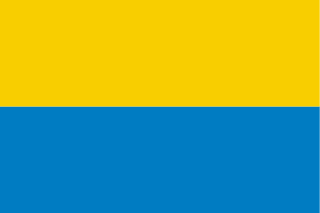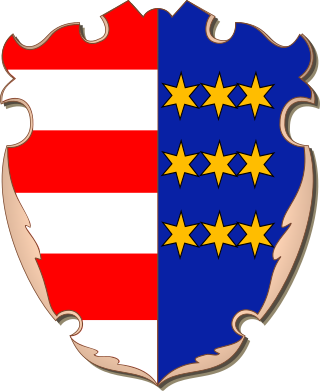
The coat of arms that serves as the symbol of the Lublin Voivodeship, Poland depicts a white (silver) male jumping cervus (deer), with a yellow (golden) crown on its neck, placed on a red background. The current design of the coat of arms was designed by Andrzej Heidrich, and adopted in 2002.

The coat of arms that serves as the official symbol of the Masovian Voivodeship, Poland, consists of a red escutcheon, that features a white (silver) eagle, with raised wings, and its head turned left. Its current version had been designed by Andrzej Heidrich, and adopted in 2006.

The coat of arms of the Lesser Poland Voivodeship, Poland features a white (silver) eagle with a yellow (golden) crown on his head that is turned left, a beak, legs, and a stripes on its wings, with the charge placed on the red background. It was designed by Wojciech Drelicharz, Zenon Piech, and Barbara Widłak, and adopted in 1999.

The coat of arms of the Greater Poland Voivodeship, Poland features a white (silver) eagle with its head turned left, and raised wings, that has a yellow (golden) beak, legs, stripes on its wings, and a ring on its tail. The charge is placed in a red Heater style escutcheon with square top and acute base. It was adopted in 2000.

The coat of arms, that serves as the symbol of the Opole Voivodeship, Poland, features a yellow (golden) eagle wearing a yellow (golden) crown, placed on a blue background. It was adopted in 2001.

The coat of arms, that serves as the symbol of the Silesian Voivodeship, Poland, features a yellow (golden) eagle on a blue background. The current version of the coat of arms was adopted in 2001, and based on the historical coats of arms of Upper Silesia.

The flag of Upper Silesia serves as the symbol of the historical and geographical region of the Upper Silesia in Poland, and as one of the symbols of the Silesian people; it is divided horizontally into two stripes: yellow on the top and blue on the bottom. It originated as the flag of the Prussian Province of Upper Silesia adopted in 1920, with its colours based on the coat of arms of Upper Silesia. The flag is also popular symbol used by the Silesian Autonomy Movement and the Silesian Separatist Movement

The flag of Podlaskie Voivodeship, Poland is a rectangle divided into four horizontal stripes, that are, from the top to bottom: white, red, yellow, and blue. It was designed by Tadeusz Gajl, and adopted on 30 August 2002.

The coat of arms of the Republic of Central Lithuania, an unrecognized short-lived puppet republic of Poland, was established on 12 October 1920 and remained in use until 18 April 1922, when the state ceased to exist.

The coat of arms of Lubusz Voivodeship, Poland, features an Iberian style escutcheon divided vertically onto two sides, of which, the left side has red background, with left side of a white (silver) eagle, with yellow (golden) crown, legs, a ring on its tail, and a przepaska on its wing, while the right side, has green background with two yellow (golden) six-pointed stars, placed vertically. It was established in 2000.

The coat of arms of the Łódź Voivodeship, Poland is an Iberian-style escutcheon with square top and rounded base. It is divided horizontally into three stripes (pales), that area from left to right: yellow (golden), red, and yellow (red), with the middle stripe being twice as big as the other stripes. It also include three charges placed in its center, with two placed next to each over, on the top of the third one. The top two charges are Kuyavian Hybrids, divided into half, into a lion and an eagle, while the bottom one is an eagle. It was designed by Marek Adamczewski, and officially adopted on 25 June 2002.

The flag of the Świętokrzyskie Voivodeship, Poland is a rectangle divided into four parts. Its left part features a yellow vertical stripe, which wight equals to 1:4 of the wight of the flag. Its right part is divided into three horizontal stripes, that are, from top to bottom: blue, white, and red. In the middle of the white stripe is placed the coat of arms of the voivodeship. The first version of the flag had been adopted in 2001, and current version is used since 2013.

The coat of arms of the Kuyavian-Pomeranian Voivodeship, Poland, consists of a white (silver) escutcheon, with a half of an eagle facing left, joined with a half of a lion facing right, both animals together wearing a yellow (golden) crown on their joined heads. It had been adopted in 2000.

The coat of arms of the Lower Silesian Voivodeship, Poland, features a black eagle with a white (silver) crescent put across its chest and wings, with a white (silver) cross pattée on its top, placed in a yellow escutcheon (shield). The first version of the coat of arms had been adopted in 2000, and current version, in 2009.

The coat of arms that serves as the symbol of the Świętokrzyskie Voivodeship, Poland, consists of the Iberian style escutcheon (shield), with square top and rounded base, that is divided in the 2 by 2 chessboard pattern. The top left field features a yellow patriarchal cross. The top right field features a white eagle with yellow crown, beak, legs, stripes on its wings, and a ring on its tail. The bottom left field features eight yellow six-pointed starts, placed in three rows, each with three stars, with the exception of the bottom row, that only had 2 stars, placed to the left.

A historical coat of arms symbolized the Sandomierz Land and Sandomierz Voivodeship of the Kingdom of Poland from the 14th to 18th centuries. It was divided into two fields, with the left field consisting of six stripes, alternating either between red and white or red and yellow, and with the right field consisting of several yellow six-pointed stars, whose number varie dbetween seven and nine.

The coat of arms of Sandomierz County is divided vertically into two fields, with the left field consisting of six horizontal stripes, alternating between red and white (silver) colours, and the right field featuring nine yellow (golden) six-armed stars, placed in three horizontal rows. The flag of the county divided into three vertical stripes, of blue, yellow, and blue colour, with the middle stripe being three times, and the coat of arms placed in the centre. The design was based on the historical coat of arms of the Sandomierz Voivodeship, used from 14th to 18th centuries.

The coat of arms that served as a symbol of Augustów Voivodeship (1816–1837), and later Augustów Governorate (1837–1867), of Congress Poland, was divided vertically into two red fields. The left half depicted a knight in a white (silver) armor, sitting on a white (silver) horse with a blue saddle and shabrack, standing on its back hoofs. The knight has a blue shield with a yellow (golden) cross of Lorraine on it, put on his left arm, and hold a sword in his right hand. The right half depicted a black bear facing left and standing on its back legs, with a yellow (golden) collar on its neck.

The coat of arms of the Warmian–Masurian Voivodeship, Poland consists of a red Iberian style escutcheon (shield) that is divided horizontally into two parts. The top part features a white eagle with a yellow (golden) crown on its head. The bottom part is divided vertically into two fields. The left bottom field depicting a Lamb of God, in a form of a white (silver) sheep with a yellow (golden) circular aureola behind its head, holding in its right hoof, a yellow (golden) cross with a white (silver) banner with red cross on it, attached to it, and bleeding from its chest, with the red drops of blood falling towards a yellow (golden) chalice placed in front of it, between its legs. The right bottom field depicts a black eagle with a yellow (golden) crown put on its neck, and a capital letter S placed on its chest.

The coat of arms of Pomerania, also known as the Pomeranian Griffin, is the symbol of Pomerania, a historical region on the southern shore of the Baltic Sea in Central Europe, split between Poland and Germany. It depicts a red griffin with yellow (golden) beak and claws, placed within a white (silver) shield. It originates from the late 12th century.

























